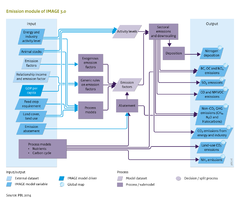Emissions/Policy issues: Difference between revisions
Jump to navigation
Jump to search
Oostenrijr (talk | contribs) m (Text replace - "NH3" to "NH<sub>3</sub>") |
No edit summary |
||
| Line 1: | Line 1: | ||
{{ComponentPolicyIssueTemplate | {{ComponentPolicyIssueTemplate | ||
|Reference=PBL, 2012; | |Reference=PBL, 2012; Braspenning Radu et al., 2016; | ||
|Description=In a baseline scenario, most greenhouse gas emissions tend to increase, driven by an increase in underlying activity levels (This is shown in the figure below for a baseline scenario for the [[Roads from Rio+20 (2012) project|Rio+20]] study ([[PBL, 2012]]). For air pollutants, the pattern also depends strongly on the assumptions on air pollution control. In most baseline scenarios, air pollutant emissions tend to decrease, or at least stabilise, in the coming decades as a result of more stringent environmental standards in high and middle income countries. | |Description=In a baseline scenario, most greenhouse gas emissions tend to increase, driven by an increase in underlying activity levels (This is shown in the figure below for a baseline scenario for the [[Roads from Rio+20 (2012) project|Rio+20]] study ([[PBL, 2012]]). For air pollutants, the pattern also depends strongly on the assumptions on air pollution control. In most baseline scenarios, air pollutant emissions tend to decrease, or at least stabilise, in the coming decades as a result of more stringent environmental standards in high and middle income countries. | ||
|Example=Policy scenarios present several ways to influence emission of air pollutants ([[Braspenning Radu et al., | |Example=<div class=“version changev31”> | ||
Policy scenarios present several ways to influence emission of air pollutants ([[Braspenning Radu et al., 2016]]): | |||
</div> | |||
* Introduction of climate policy, which leads to systemic changes in the energy system (less combustion) and thus, indirectly to reduced emissions of air pollutants ([[Van Vuuren et al., 2006]]). | * Introduction of climate policy, which leads to systemic changes in the energy system (less combustion) and thus, indirectly to reduced emissions of air pollutants ([[Van Vuuren et al., 2006]]). | ||
* Policy interventions can be mimicked by introducing an alternative formulation of emission factors to the standard formulations ({{abbrTemplate|EKC}}, {{abbrTemplate|CLE}}). For instance, emission factors can be used to deliberately include maximum feasible reduction measures. | * Policy interventions can be mimicked by introducing an alternative formulation of emission factors to the standard formulations ({{abbrTemplate|EKC}}, {{abbrTemplate|CLE}}). For instance, emission factors can be used to deliberately include maximum feasible reduction measures. | ||
Revision as of 21:40, 6 November 2016
Parts of Emissions/Policy issues
| Component is implemented in: |
Components:and
|
| Projects/Applications |
| Models/Databases |
| Key publications |
| References |
